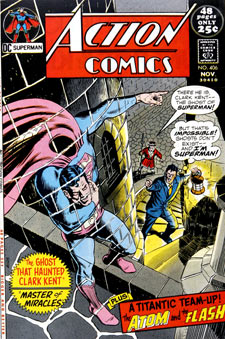 The
Ghost That Haunted Clark Kent
The
Ghost That Haunted Clark Kent
Horror was huge in 1971 with the success of recent films
Rosemary's Baby and Night of the Living Dead,
and about to get even bigger with soon-to-come terrors like
The Exorcist and Jaws. Quick to jump on
the bandwagon, Marvel reprinted its classic pre-superhero
monster tales under titles like Fear and Monsters
On The Prowl, with Tomb of Dracula and Monster
of Frankenstein in the offing. Meanwhile DC offered
us House of Mystery, Tales of the Unexpected and
Ghosts.
Inevitably, the spandex crowd got in on the act, with Spider-Man
growing extra arms to battle a "living vampire"
while Batman -- undergoing a return to
his creepy roots thanks to Denny O'Neil
and Neal Adams -- faced off against werewolves,
ghosts and the like.
It never quite worked with Superman, however;
something about the guy was just too sunny and upbeat to
make the creepy stuff work. Maybe it's just because "things
that go bump in the night" are no mystery to a guy
with x-ray vision, nor boogeymen a physical threat to a
guy impervious to nuclear explosions. That didn't keep DC
from trying, though, as witness Action Comics #406
(Nov 1971), featuring "An Untold Story of Clark Kent"
by one Geoff Browne, with art by the great
Curt Swan/Murphy Anderson team.
We open to find Clark at the Tower of London, where a "beefeater"
has just spotted one of the unearthly spirits England is
so famous for. Capturing footage of the "headless phantom"
with his movie camera, Clark notes it will "make a
socko climax for my TV special about London!" (That's
our Clark; always thinking big. Here he's got photographic
proof of ghosts and he's thinking about how to edit it into
a travelogue.) On closer inspection, Clark finds the ghost
looks distressingly familiar:
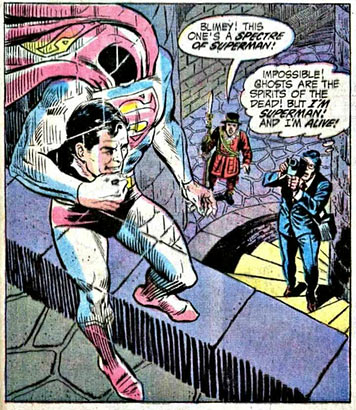
The ghost soon dashes off, but Clark follows it with his
x-ray vision and sees it "passing through the stone
walls into a sealed-off room" and "putting his
head back on!" The until-now incorporeal "ghost"
then takes solid form, apparently as a double for the Man
of Steel.
Slipping away in feigned panic, Clark changes to Superman
and smashes into the hidden room to confront his "double,"
only to find the resemblance ends at the costume:
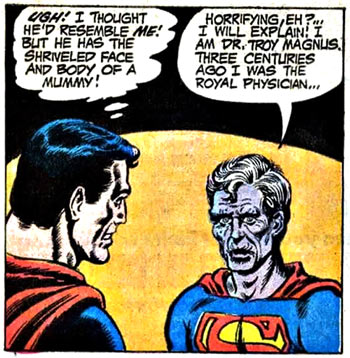
The mystery man identifies himself as Troy Magnus,
and claims to have been England's royal physician way back
in 1665, when the Plague was terrorizing Europe. Desperate
to end the tragic loss of life brought on by that scourge,
the then-young physician had developed an elixir designed
to provide immunity, and tested it on himself.
As Magnus continued to minister to plague victims without
succumbing himself, it appeared his antidote had worked.
But then one day he exhibited the early symptoms of plague,
causing his assistants to flee in terror. An odd thing happened
next, however: Magnus' body turned translucent, then spectral,
before returning to normal and leaving him free of plague
symptoms and infused with new vigor.
There was a terrible side effect to his cure, however:
Magnus had become a carrier of the plague, spreading it
to still more victims. Horrified, he asked members of the
Royal Guard to kill him for the greater good, but when they
tried to comply, another side-effect of the potion was revealed;
it had rendered him invulnerable to mortal harm.
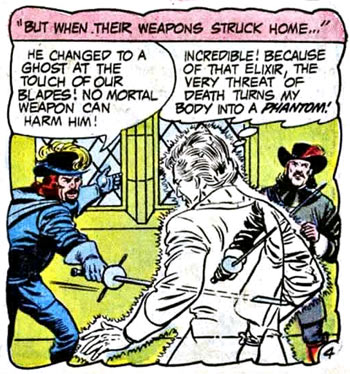
With no other recourse, Magnus asked the men to wall him
up in the Tower for eternity, which they did. At this point
you have to wonder, why didn't Magnus just work on the elixir
in isolation, and once he'd completed it, send it out for
everyone in England to use? They'd be safe from him until
they drank it, at which point they'd become safe from everything,
forever. Of course, taking the elixir would also mean they'd
eventually kill everyone they touched outside of England,
but hey, they were going to get around to that anyway, right?
Cheaper than cannonballs and gunpowder.
Years in the walled-in Tower room become decades and then
centuries, as Magnus also seems to have gained the ability
to survive without food or water. To pass the time, he tinkers
with his hobby of alchemy, trying to turn lead to gold with
an apparatus that looks to be made mostly of mirrors (reflecting
light from a "bowl of radiant chemicals"). Whenever
that gets boring, he turns into a phantom and floats around
London.
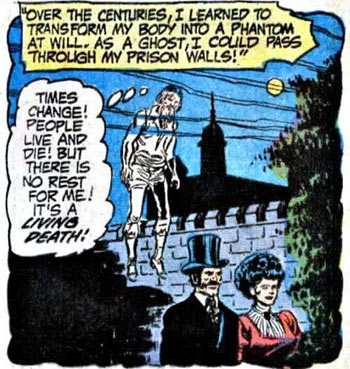
So it went until today, when Magnus spotted Clark Kent
visiting the Tower and somehow (I guess using his "phantom
insight" power) learned his secret identity. Then,
"using sheer mental power, I transformed my phantom
shape to that of Superman...to lure you here." Presumably,
that "mental power" also allows Magnus to remove
and re-attach his head at will; it's never definitively
stated. However, once he's back in solid form, Magnus still
wears a Superman costume, which begs the question of how
he acquired it living in a walled-in room for 300 years.
When Superman asks why Magnus lured him to the
room, he gets a pathetic reply:
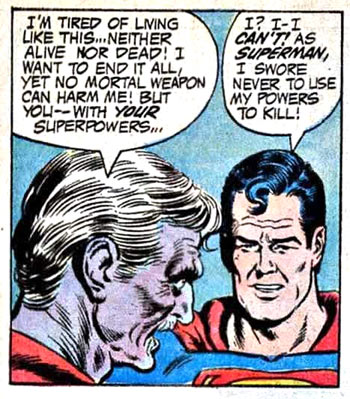
Magnus pleads for a mercy killing, but Superman says, "You
don't know what you're asking! I gave a sacred oath to use
my powers only to serve mankind!" As a physician, Magnus
understands about such oaths and so he asks only that Superman
use his heat vision to seal the cracks he made in the wall
when he entered, lest the plague germs escape to the outside
world (Oops! Should have thought of that about four pages
ago, Supes!).
He agrees, but his eye beams accidentally strike Magnus'
alchemy device. When the old man dashes in to protect the
apparatus, he's hit by a ricochet from one of the mirrors
and suffers a fatal burn.
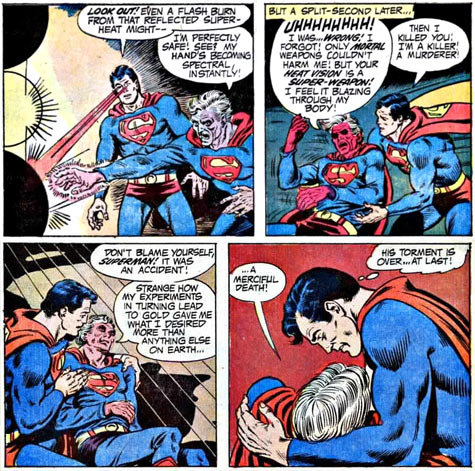
And so with the blessed relief of death having come to
Magnus at last, Superman seals the poor guy's body in the
Tower for good. "That laboratory was his tomb for centuries."
says Superman. "Let it be his tomb forever!"
Or at least until a restoration project unearths him, loosing
the plague virus on London.
This doesn't really add up, of course. Since when does
Superman have so little control over his heat vision that
he strikes objects unintentionally, and can't turn it off
before before a half-mummified geezer runs in front of him?
For that matter, what's up with the "alchemy device"
anyway? It's made of "parabolic mirrors" on a
system of adjustable stands that looks pretty advanced for
1665. Even supposing for a moment Magnus could
change lead into gold, what good would it do him, walled
up in a lonely prison where he can never buy anything?
As Superman is walling up Magnus' body, he ruminates, "The
poor man didn't realize that atomic scientists of our age
transmuted metals long ago..." Now I won't claim to
be an expert in Physics, but if someone had figured out
a way to turn lead to gold, I think I'd have heard about
it. (I Googled "transmuting metals" and saw they've
managed to create some highly radioactive materials through
"nuclear transmutation" of boron and aluminum
using reactors and particle accelerators and such, but I
don't think that's what Magnus was aiming for. He's already
got the plague in that room; does he really need to turn
it into an unshielded nuclear reactor to boot?). The thing
is, they could've just as easily have Magnus hit by the
heat vision without adding on the superfluous "alchemy"
angle.
Anyway, it's interesting that the writer had to go to such
lengths to "explain" the headless phantom featured
on the cover of this book. Even though what we end up with
is as far-fetched as any ghost story ever was, there seems
to be a tacit admission that ghosts as such just
cannot exist in Superman's universe.







